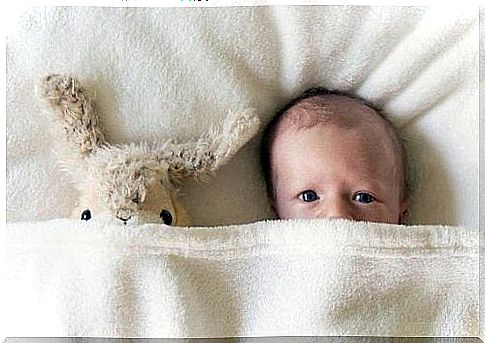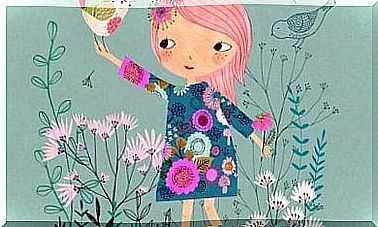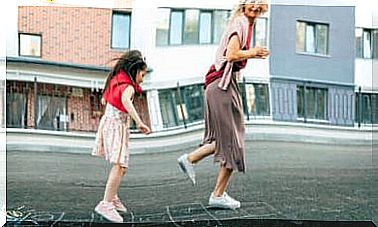A Newborn’s Vision – I See You, Mother: When A Newborn Discovers You

A newborn’s vision: few moments, are as wonderful as when we visually feel connected to our newborn children. The moment you discover that your baby is looking at you, more emotions are aroused. But what do they really see? Can they distinguish between their mother’s face and other family members?
A newborn’s vision and eyes undergo many changes during the first 6 months of life. We need to pay close attention to every nuance, such as how our baby focuses his attention on objects. The eyes are an indispensable and wonderful channel through which our children discover the world.
Now we are sure you will not be surprised by this fact. But during a baby’s first few weeks of life, there are only two important things to focus on: you and milk. Both things represent survival. But something fascinating will also happen.
Your child will begin to recognize the meaning of your face. Over time, he will begin to seek you out and become even happier to see you. The survival instinct is combined with the power of love, and it is something that is never broken.
Today we invite you to discover the different aspects of a newborn’s vision.
I’m looking at you mom because you’re close to me
A newborn’s vision is genetically programmed to feel connected to other people, especially their parents. Newborns have a very blurred vision for long distances. They cannot clearly see objects more than 30 or 40 centimeters from their faces.
This poor vision for long distances in the first few months of life, also responds to the survival instinct by reducing stress, fear and anxiety to focus on the important thing: the faces surrounding him, mother’s breast or bottle.
Let’s look at some more interesting details, below.

A newborn’s vision: newborns establish quick visual contact with their mother
He sees you, he looks at you, and he knows who you are. Few things are as important as allowing an intimate and long-lasting meeting between mother and child right after birth. Not only is established, the first visual contact, and skin contact, which provides security, but also stress is reduced, and the first connection between mother and child is created.
Faces are full of amazing stimuli for a newborn : the mouth emits sound, the eyes move around, and the face itself has contours that delimit everything that is important for a baby to recognize.
It’s great for babies.
My baby squints
Do not worry, the squint is completely normal. During the first 6 months of life, the brain learns to focus its attention and must develop this process. Although it does not look like it, it is extremely complex.
It is common to see babies squint during the first 2 to 4 weeks of their life. Their vision is still not very accurate, and parents sometimes panic a little when they see their baby’s eyes squint.
We must keep in mind that most of the child’s visual development takes place in the brain, not in the eyes themselves.
Thus, one of the biggest challenges for the developing brain is coordinating the visual signals on both sides. The nerve signals from the eyes travel through the optic nerves and separate to both sides of the brain.
It is a very complex process that requires time for development. Eventually there will be coordination of each eye in the desired direction.

Main visual milestones
After two months, we can enjoy watching our children follow our faces, look at us between smiles or look with great interest at a toy, even from left to right.
When they are two or three months old, a baby can distinguish between faces and be intimidated by strangers he has never met.
It is also the age at which he will enjoy visual stimuli the most, such as a restlessness on his cradle. But since babies’ attention is easily diminished, they appreciate every story and fun stimulus that you offer.
The next major visual milestone occurs at 6 months of age. It is now the time when both sides of the brain are already at an optimal level of coordination and maturation.
Children are now very curious, looking, searching and discovering. Most importantly, their coordination is now perfect. We can cover one eye and they will continue to look for a stimulus with the other. However, when your child is 6 or 7 months old and you notice that he is still squinting or that one of his eyes is suddenly crossing, do not hesitate to consult your pediatrician and ophthalmologist.
The color of a child’s eyes
There is a very common myth. It is one that we have all heard many times. We have been told that the blue color of a child’s eyes is due to the fact that he is still drinking breast milk.

There is no scientific basis for this assumption. That is simply not true. The color of the iris, like hair and skin color, depends on a protein called melanin.
When a baby is born, it is common for the eyes to be gray or blue because he has spent a long time in a dark environment and his melanocytes are not yet mature. This process takes time and will change a little every day.
This process of maturation and change (or not) of the color of a child’s eyes, develops differently in each child and depends on genetics. However, after 6 months, a particular color begins to be defined and it becomes fully developed at the age of 2 years.
In conclusion, few things are as magical as the moment we realize our baby is looking around and seeing us. He knows that we are a person who is important to him, that he needs us, and that little by little he will discover many more things about us and about everything that surrounds him.
Do not neglect the care of your baby’s eyes, and if you notice any small anomaly, do not hesitate to take him to a good pediatrician.









